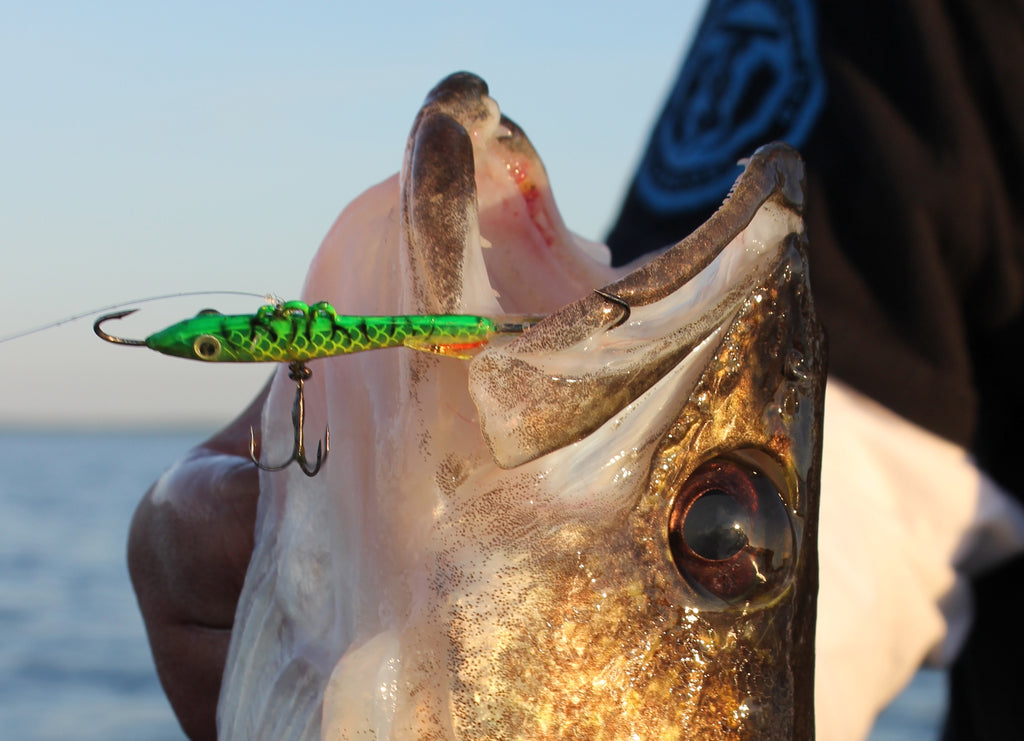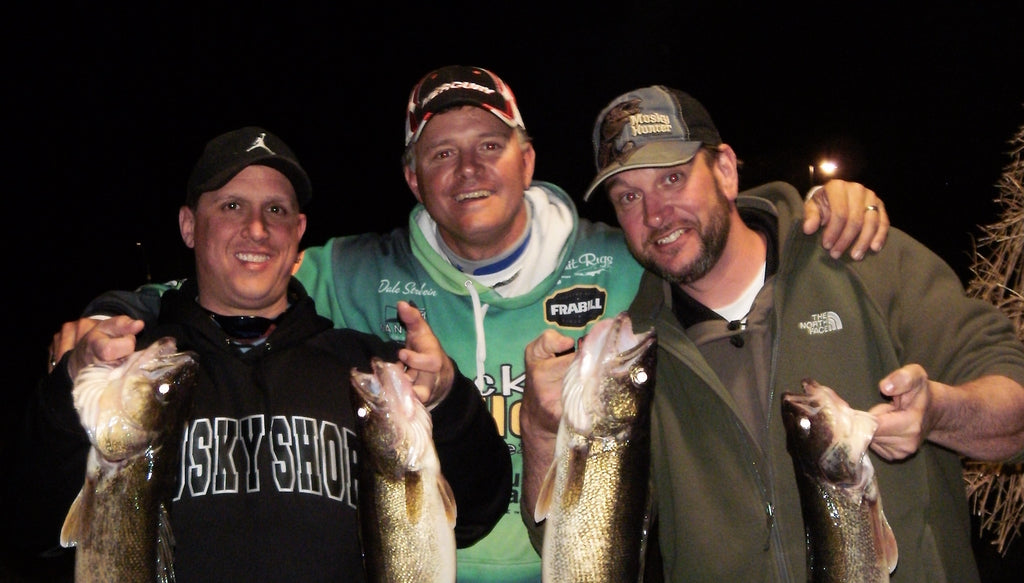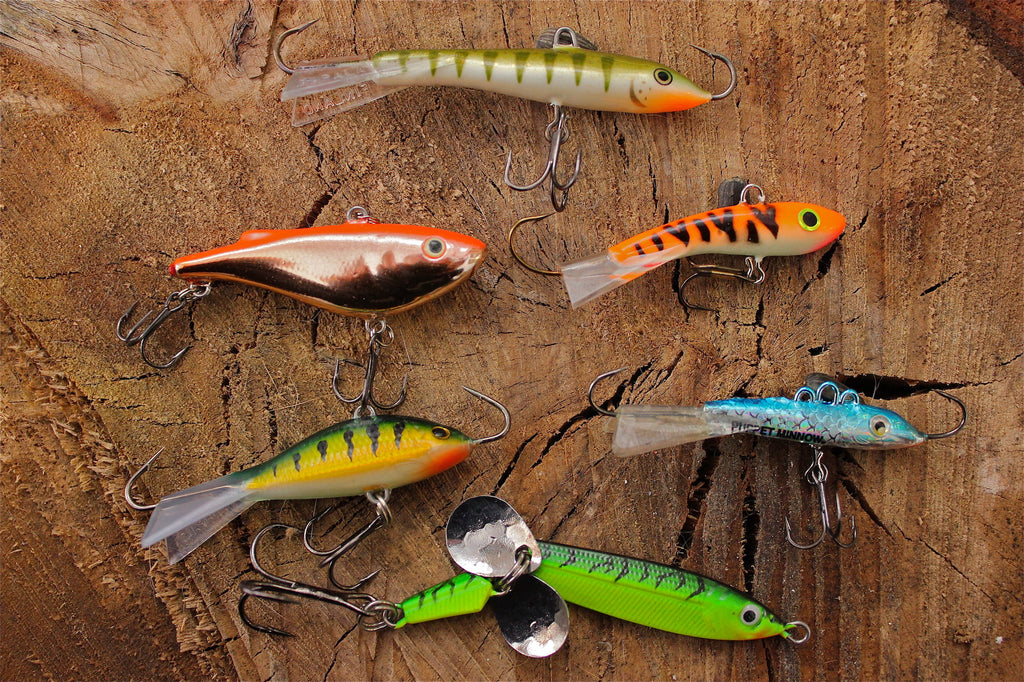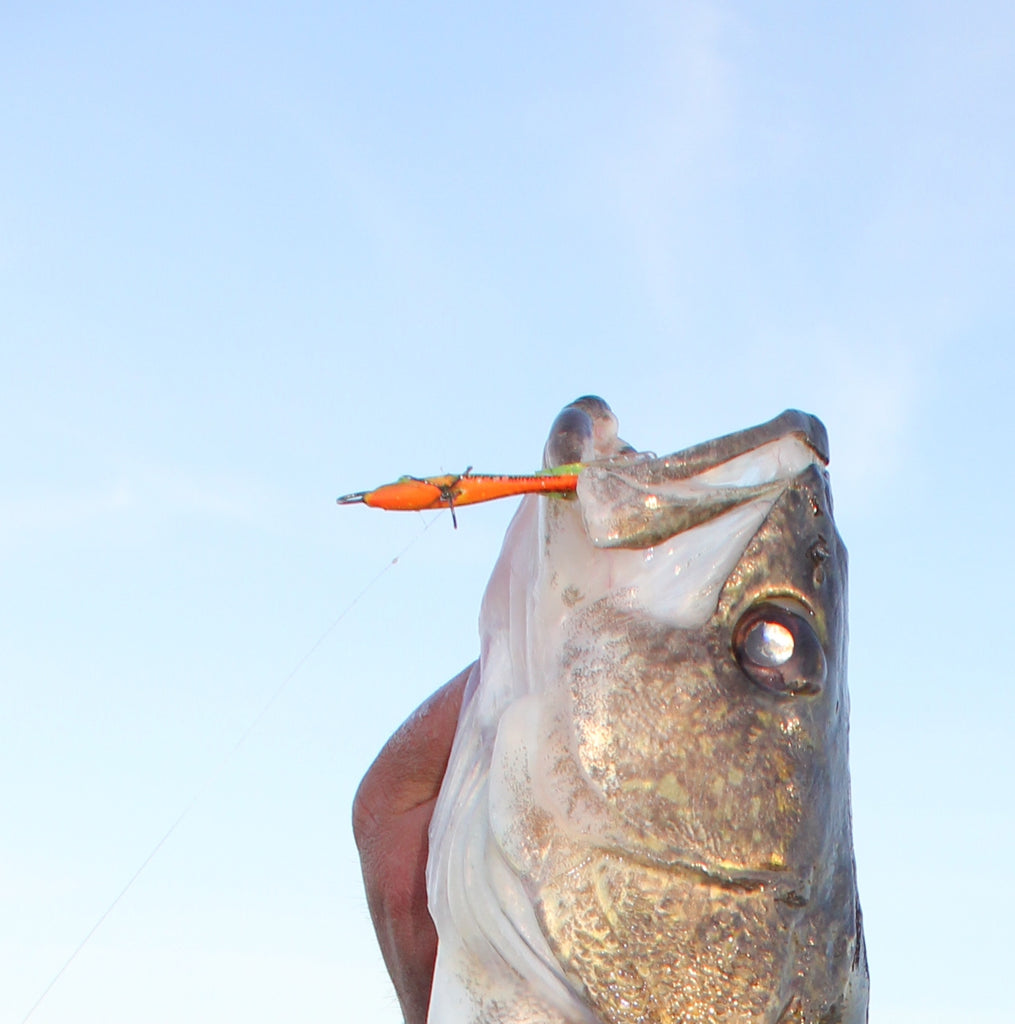What do brown trout, muskies, bass, reds, blues, sharks, walleyes, pike, and salmon have in common? Obviously, they’re all fish.
But a violent response to rip jigging would be accepted. (Even on Jeopardy.)

A friend taught me long ago that a cheap, unpainted, ball-head jig tipped with a white pork strip could consistently take big pike all summer long when “ripped.”
He pitched from the deep weedline—out on the flats or right along the edge of the weeds and let the jig fall to bottom. As soon as the jig made contact, he ripped it up about 4 feet while reeling up a little slack, then he let it fall. And he just kept repeating that process until the jig was directly under the boat or the rod doubled over violently.
The jig makes a series of plumes along bottom that predators will follow. I’ve since watched that same, basic retrieve make a killing for all kinds of fish. Salmon pro John Oravec of New York showed me how he did the same thing with jigging spoons for brown trout in harbors during the cold months. He basically trolled 1-ounce slab spoons very slowly, and every time the jig hit bottom he ripped it upward about 5 or 6 feet with a long rod.
Then came the ubiquitous “Griz.” Way back in the 1960s, Dick Gryzwinski (one of Minnesota’s most treasured guides) began “snap trolling” for walleyes.
Using no bait (still considered heretical by traditional walleye fishermen), he powered along, trolling forward, with a heavy feather jig.
When it hit bottom, he ripped it up. “That was before depth finders,” Gryzwinski said.
“We’d find our favorite bar with heavy sinkers and throw a white jug out. I had some ½-ounce Lee’s Jigs back then—the only feathered jigs I knew about. They were white or white-and-yellow. And I started snapping them. Didn’t need bait.
We started catching fish one after another. I can’t even remember why we started ripping jigs like that, but I used the motor to forward troll at over 4 mph while doing it and we’d catch 200 to 300 walleyes per day, snapping the jigs forward, following them back down with the rod tip and snapping them again.”
Many walleye pros and guides all over the Great Lakes region have adopted snap jigging as their own, without really knowing who started it all (thanks, Griz). The list includes names like Johnnie Candle, Rick Olsen, Tommy Skarlis, and Ted Takasaki.
They may call it rip jigging or power jigging, and they may use different jigs or plastics, but it’s the same idea—the same one my pike-fishing buddy had 40 years ago. Whatever you want to call it, snap jigging puts big walleyes in the boat from ice-out to ice-up.

The Green Bay Rippers
No matter how big the lake, when walleyes are grouped up or concentrated, rip jigging is the way to go. Rippers from the Fox River north past Sturgeon Bay, including several guides and pros, have reported how effective snapping jigs can be for Green Bay walleyes. They call it rip jigging.
Former Professional Walleye Trail pro, Dale Stroschein, owns Sand Bay Resort near Sturgeon Bay, Wisconsin. He guides for his guests on some of the world’s premier walleye waters, including Green Bay and the Fox River. But, because these are world-class waters, pressure can be immense.
“This is a hotspot for walleye tourism,” Stroschein said. “So many anglers come here, the pressure is overwhelming. I needed something to set that me apart from all these other guides and great anglers, and snap-jigging with blade baits in the Fox River was it. That led me to rip jigging out in Green Bay and here in Sand Bay, and it’s incredibly effective.”
As with most Great Lakes fisheries, Green Bay is big, exceptionally clear, and the primary tactic is trolling. Otherwise, finding active pods of walleyes seems like an intimidating task. “Last year, we had so much wind out on Green Bay we couldn’t troll with precision half the time,” Stroschein said. ”So I tried to get a jig bite going. I marked small groups of walleyes on rock-to-sand transitions and started snap jigging them the way we do in the river where the water is cloudy. With the waves churning up the water, I knew ripping baits would trigger walleyes. Unlike ripping in the river, which is vertical jigging, we started casting to them. The results were dramatic. If I could mark walleyes up off bottom with sonar, I could catch a few from each pod by snap jigging.
“But what surprised me is how well it works in calm, clear water,” he added. “In those conditions, we’re watching trollers with boards parade by without ever breaking the net out and we’re crushing fish. And the technique is versatile in terms of where it can be applied. We snap jig from depths of 3 feet down to 25 feet deep by playing with the weight and style of jigs and plastics.”

Tackle For the Technique
“You need a fast stick with the right action,” Stroschein said. “Nothing heavy, though. A fast-action, medium-power, 6-foot spinning rod is fine. The critical element is superline. When you’re trying to snap jigs up off bottom, mono stretches and absorbs action. It makes your jig look sleepier and slower down there than you think. I use 10-pound Berkley FireLine or 10-pound Nanofil with a 2-foot, 12-pound Vanish Fluorocarbon shock leader. You’re essentially setting the hook every time you snap the jig.”
Roach agrees with Stroschein: “Braided lines are best. When ripping jigs back to the boat, braid won’t slow you down with stretch like mono. Braid rips a jig out of the weeds clean with a snap of the wrist. I spool up with 6-pound Northland Tackle Bionic Braid. I tie it to a barrel swivel, and I add a couple feet of 6-pound fluorocarbon leader below that, tying directly to the jig.”
Roach doesn’t use fluorocarbon so much for stealth as for its low stretch. “Mono works, but fluorocarbon’s a little stiffer,” he said. “You’re ripping these baits up. Braid is so limp it allows the lure to flip, roll over and tangle on itself. Fluorocarbon won’t let that happen as often. It’s stealthy, too, creating a visual separation between the opaque braid and the lure.”
A horizontal jigging lure, like Roach’s favored Rapala Jigging Rap, maintains a horizontal posture longer with a stiffer leader when it’s being snapped, creating a natural look. But a lure is going to spin and roll sometimes, so the swivel is there to eliminate line twist.

“As the water warms, I fish faster so they can’t get a good look at it,” Roach added. “Livebait slides down the shank or gets foul hooked when you fish really fast and hard. The faster you rip the jig, the more erratic the action becomes. Soft plastics start to greatly outproduce livebait jigging presentations because you can fish much faster, and you get the desired action out of the artificial.”
Roach tips his jigs with plastic grubs, ring worms, soft jerkbaits, and shad bodies.
“I fish Northland Tackle jigs like the ¼-ounce Gumball or 3/8-ounce Slurpie Swimhead with plastics,” he said. “If they want a smaller package I downsize to a 1/8-ounce FireBall—getting better hookups that way with the shorter 2-to 3-inch plastics. The Norhtland Tackle Impulse Paddle Minnow is great for that.”
Softbait colors provide an intriguing dimension, mimicking the predominant forage or providing flashy attraction. “It all depends on the water clarity,” Roach said. “In stained water, I go with bright whites, fluorescent chartreuse, or glow because I want fish to see it when I’m fishing fast. In clear water I fish extremely fast and barely let it hit bottom before ripping it again, so I go with white with silver or gold, or perch patterns—natural batifish colors. I let it sit on bottom more in rivers or in stained water. But in clear water, I never let it pause. Don’t want them to get a really good look at it in clear water. In rivers I pause on bottom then rip. It may not look like it to the casual observer, but it’s a big diffrence. Jigging Raps and Northland Puppet Minnows are my favorites in clear water because they have that natural baitfish profile.”
Technique For the Tackle
Stroschein covers structure fast where he sees active walleyes up off bottom. He backs the boat off and casts 30 to 40 feet, letting the jig fall to bottom, following it down on a semi-taught line. “I start with the rod at 3 o’clock and snap it up to noon,” he explained. “The jig is jumping 3 to 4 feet up. As soon as I finish the up motion, I make a half turn with the reel handle as I drop the rod tip, following the jig back down. As soon it touches bottom, I make another half turn just as I start to snap the jig back up, trying to get as much slack out of the line as I can. The jig isn’t allowed to rest. It’s constantly in motion.”

Roach explains the technique as repeating a hook-setting motion. “You’re really setting the hook,” he said. “Every time you move the jig, just set the hook. Watch the line as it’s going down, too. Most strikes come on the fall, but walleyes nail it as it hits bottom, too. After the first couple rips it’s all about timing. Don’t bother watching the line. Create a rythym and let it tell you when it should hit bottom. If it stops early—set the hook. I drop the rod tip down low and rip it up 2 to 4 feet. It’s a timing deal. Sometimes you don’t feel strikes. You just feel weight when you snap it and, presto. If you’re doing it right, the hook’s already set.”
Common sense says this is a warm-weather tactic, but, “It works all year,” Stroschein said. “We started last April and it worked until ice-up. We go to the traditional spots and we know within minutes if they’re there. If walleyes are there, you’ve got one on immediately.”
Stroschein’s clients are learning to appreciate snap jigging. “My clientele has been challenged by it, but they’re catching on and they want to learn more because it’s successful. Your brain has a millisecond to react to that added weight on the up-swing of the jig. Your brain is telling you, out of habit, to drop the jig back down when you already have a fish on. It takes a little getting used to, but once they get it, they’ve got it.”

Roach does alter his presentation a little based on water temperature. “In spring it’s more of a pop-drag, pop-drag,” he said. “In summer I’m ripping it straight up, letting it fall, and ripping when it hits again. Walleyes do seem to want you to slow it down a little when water temperatures are in the 40°F range, but not that much. It’s surprising how aggressive you can be with a jig and be successful no matter what the conditions are.”
Anglers on Lake Erie, Lake St Clair, and Lake Huron could easily adapt Roach’s method of hunting individual fish when walleyes are scattered but within 5 feet of bottom. He covers large areas quickly (5 mph or more), creating a grid on his GPS screen. When he spots a fish off bottom, he pops the boat into reverse and pitches a jigging lure about 30 feet, back into the boat’s bubble trail and begins ripping as it hits bottom. “We bat about .333 doing that,” Roach said. “If you mark them up off bottom, they’re active. They’re going to bite if they see it, so it’s an exciting way to fish.”

Roach spends the summer with two options on his deck: Power-jigging rods and leadcore trolling rods. When fish are scattered, he trolls. If walleyes are concentrated, he jigs. But big-water jigging can’t be confined, like vertical jigging in rivers. Summer is a prism for walleyes: They hit it and spread into dozens of patterns. So many forage options, so little time. They’re always on the move.
Power jigging, unlike vertical jigging, aggressively tracks walleyes wherever they go.
Rip, power, jerk, or snap. Call it what you will. The basic idea Gryzwinski came up with over 50 years ago is catching fire. Again. In all that time, nothing changed, except minds.
- written by Matt Straw


2 comments
Very interesting.
Thank you for sharing.
Hey Matt…I have been jig-fishing, with the same technique described in your article, since 1987. A 1/2 oz chrome Crippled Herring is deadly with this technique. The only differece is, I do not overwork the rod. The flash coming off its bright chrome surface, and off its tail attractor blade, make this rig hard to beat on Lake Erie. I almost always cast directly into the boat’s drift, especially on a fast drift. When the wind really picks up, I attach this same jig to a bottom bouncer and drop my offering straight down to the bottom for amazing results. I learned this bottom bouncer tech out of desperation when 25-30 knot winds suddenly came up years ago. Now, I can jig a Crippled Herring any time on Erie without resorting to a different technique.